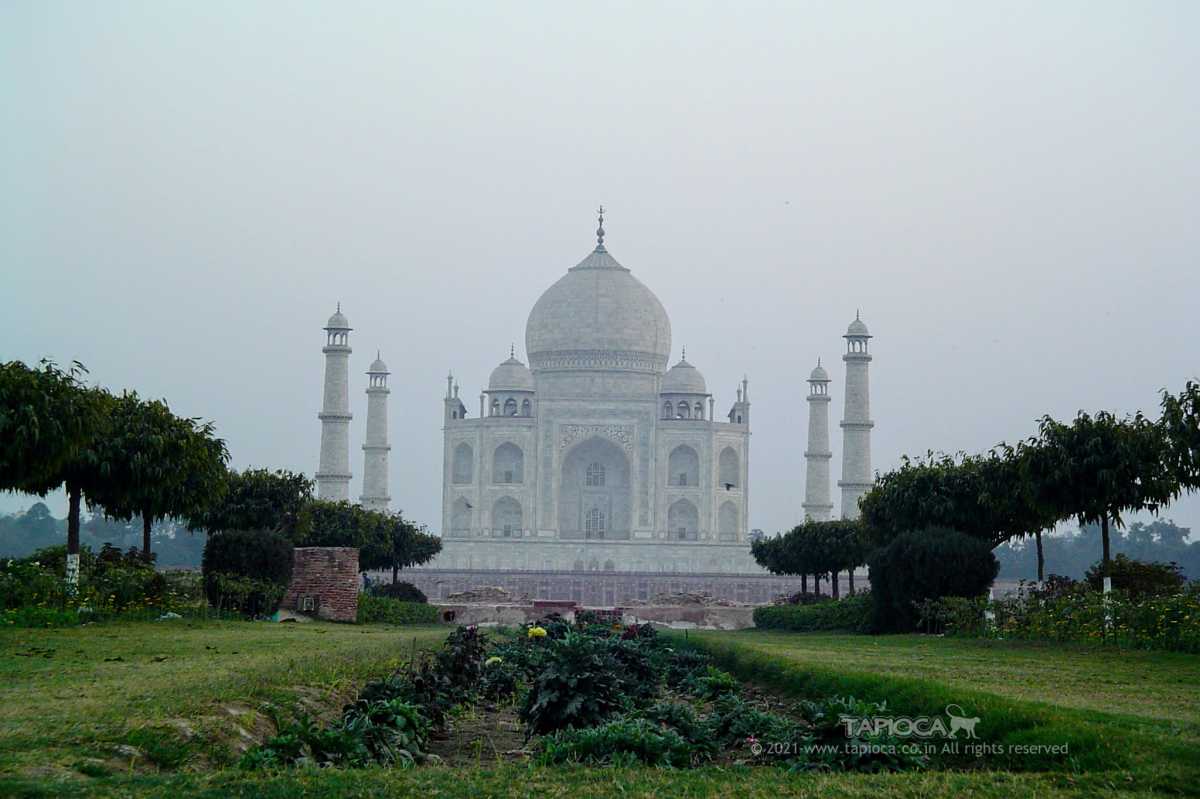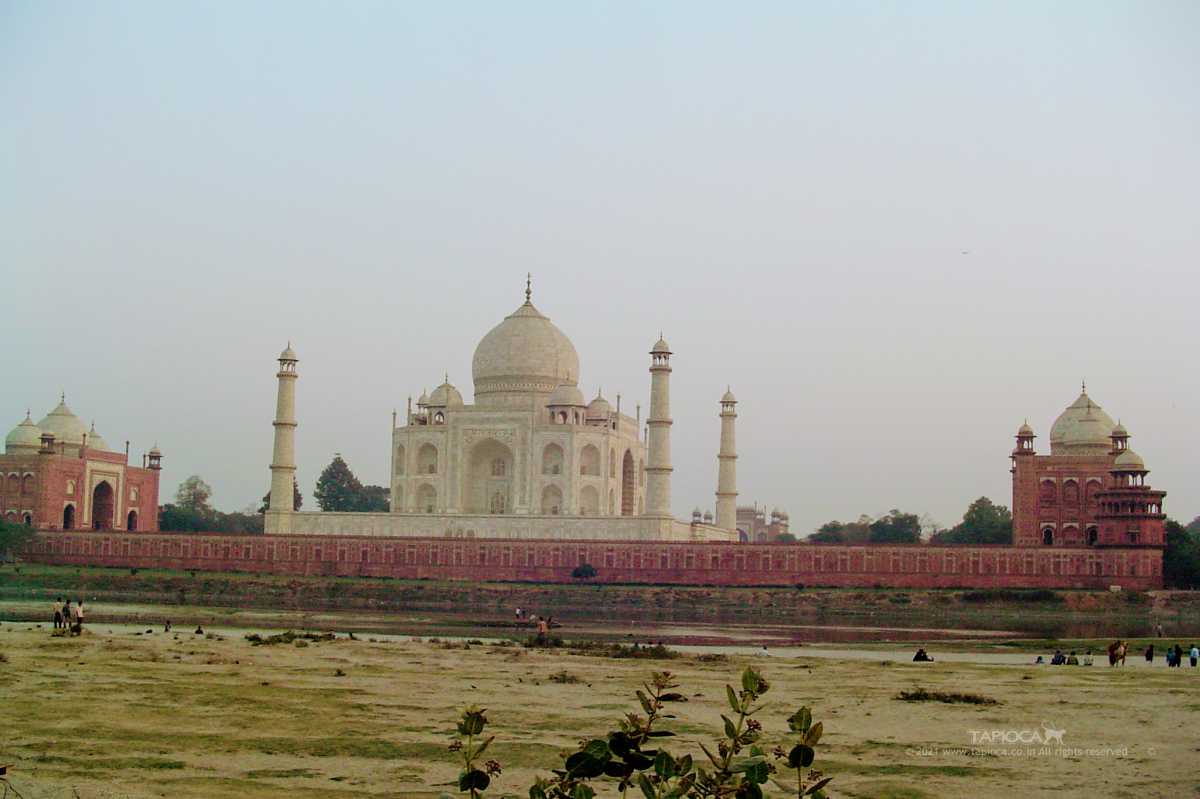Photography in Taj Mahal
These types on photography are meant for the typical tourist to Taj Mahal and also for the photography enthusiasts.

Taj seen from Mehtab Bagh
Taj seen from Mehtab Bagh. Arjumand Banu Begum or more popularly known as Mumtaz Mahal was Shah Jahan’s third wife and the daughter of Shah Jahan’s step-mother Nur Jahan’s brother, Asaf Khan. She is world-famous not just for her 19 long loving years of married life with Shah Jahan but also for the memorial built for her after her death, the beautiful Taj.
T
o state the obvious, Taj is photogenic, probably one of the most photographed monuments in India.Enough is said about the architectural beauty of Taj. So we'll leave that and get into other reasons why Taj is a photographers delight. One of the reasons is the very material - white marble - with which the whole Taj ( ie the mausoleum) is made. The marble used is somewhat translucent and a lot reflective.That means the surface of Taj Mahal reacts interestingly with light.
That's one reason why Taj looks differently during different times of the day and also during different months of the year. This essentially means you can never 'finish' photographing Taj. Every time you shoot, you are capturing a different mood of this monument. It has character.
The second reason for its Taj location. Of course photography was yet to be invented, but the architects wanted Taj Mahal to stand out every intrusions in is background. The location - on the banks of River Yamuna - was thus selected. Unlike many imperial mausoleum Taj is not standing at the center of a garden. Rather its located is at one end of a sprawling flowerbed Mughal style garden. Beyond that , as mentioned earlier is the river and its banks.
The architects felt that also is not sufficient enough to give an unobstructed view of the Taj from any direction. They made a giant plinth (platform) of 6.7 meters (22 feet ) height and the whole structure of Taj rests on this plinth.
As is to get a better composition and contrast two red stone structures are erected on either sides of the Taj Mahal. While one of this is a Masque, the other is architecturally called Jawab (answer). The function of the Jawab is just to balance the un-symmetry in composition introduced by the Mosque. But both of these structures are designed far from the central mausoleum to have an unobstructed view of the Taj.
What they achieved by all these is a tasteful presentation of the Taj with nothing but sky as the backdrop. And that plays to your advantage as a photographed. Of course when you shoot Taj Mahal at close range, you have to shoot over the shoulders of many hundred visitors. That's another aspect of photographing Taj anyway.
In simple terms you've two perspectives to photograph Taj. The first one is from inside the Taj Mahal complex. Most of the standard shots of Taj ( that cliche front shot of Taj you see everywhere) is taken from in side the Taj as one walks towards the mausoleum across that sprawling garden. The second option ( rather many options) are meant for those want to take shots those not so common angles. These are shot from outside and also in some cases, from considerable distances.
We'll see in details about both the options. Let's Take the inside option first. This is possible on everyday from 6 am to 7.30 pm (ticket counter closes at 5.30 pm) except on Fridays.
Taj Mahal faces south and quite a long shot is possible from the from of the Taj. The same can't be old about the side perspectives. Taj is overwhelmingly larger than you imagine.Somehow the simplicity of its outlines hides this factor in all the photographs of Taj one typically sees.
Like mentioned earlier Taj stands on a giant marble tiled platform. This courtyard around the mausoleum reflects the light well on to the wall making it a great advantage for photography, especially during the brighter part of the day. Be careful with the camera settings so that too much lighting will not wash out your images. Keep in mind you are shooting a huge well lit white object.
You generally don't get a high vantage point to shoot Taj. The closer you go Taj looks unusually big calling for a wide-angle shot. That's the limitation in experimenting with many angles. Carrying a wide-angle lens is not a bad idea , if you are fan of architectural photography.
One of the best (and popular among the photographers) is to shoot Taj during the sunrise and sunset, more so during the sunset. Like mentioned earlier the white marble has some amazing optical characteristics. What it means the mood of the Taj changes with the sliding sun. The white gleaming marble slowly started glowing with a golden tint. A few moments later it turns pinkish and then whole Taj appears with a bluish hue. By this time the sun has already slid into the horizon. All this happens in a matter of few minutes. And the changes happens faster than you think.
What it means is do not waste time in looking for better angles and positions when the 'dramatic events' start. Survey the place and position yourselves, check the camera settings (ISO!) and ready yourselves to shoot well before the sunset. Keep shooting before the light finally fades away. If you want to try a different location in midway do it fast.
Imagine you are shooting with fading light that too without a tripod. Yes! tripods are not allowed inside Taj complex. So that's about shooting inside Taj.
Now let's see some long shots from outside the Taj Mahal complex.
One of the favorite spots - and much less crowded - location is behind the Taj and across the river. Getting there is not so simple and quick , though there is road connection.
Taj & Yamuna
This 'other side' the Taj is called the Mehtab Bagh. This is the location where Shah Jahan wanted to build another mausoleum for himself replicating the Taj, but in black marble. For some reasons the Black Taj did not materialize.That's another myth surrounding the Taj anyway.
Back to the photography, at Mehtab Bagh you will not find many significant subjects other than a well maintained garden, originally built by Babar. As you go close towards the riverside you can get a panoramic view of the Taj. Now you are straight behind the Taj Mahal just separated by the wide Yamuna river. Depending upon the season of the year, the river shrinks and exposes wide sand beds.
Be prepared to touch the murky waters (read as Agra's sewage !) of Yamuna if you want to go further closer and experiment with angles.
This is a vantage location for sunrise and sunset photography. On this side of the Yamuna are many villages.
Other attractions on this side of Yamuna include the remains of Humayun's observatory ( called Gyarah Sidi or 11 steps) and an a Mughal era mosque called Panchmukhi (five-arched).
Reaching Mehtab Bagh is a bit tricky.You needs to have a private vehicle, or hire an auto rickshaw to Mehtab Bagh. If you are driving yourself, cross the Strachey Bridge (that scary long iron bridge located a bit west of Taj Mahal ) and reach the opposite side of Yamuna. After crossing the bridge turn right . On your right you can see the river. Trace the river bank till you get the sight of Taj on the opposite bank. Look for vantage spots for photography on the riverside or on the sand beds. They even grow vegetables on the exposed sand beds. Further ahead you'll hit Kacchpura Village. Ask for Mehtab Bagh. Now you are right behind Taj Mahal, across the river!
Another favorite location is Taj Protected Forest area some half a kilometers (2 1/2 furlongs) east of Taj Mahal. The bulbous domes of the Taj sandwiched between the domes of the Mosque and the Jawab projecting over the green cover of the forest is good theme. In the morning sun is behind you, it a great place to capture the Taj emerges from the mist.
Similarly a kilometer (5 furlongs ) or so west of Taj is a open tract of shrubby land. There are possibilities of long shots with not so common compositions of Taj Mahal.
And finally you can get some long shot of Taj from the top of Agra Fort. In fact Shah Jahan spend his last days here (under house arrest by his son ) at a pavilion called Musamman Burj (Saman Burj or the Shah-burj). The balcony overlooks Yamuna with a good view of Taj at a distance. If it is a clear day without much of haze you can get some good long shots of Taj from the Agra Fort. You can even try the shots though the river facing windows of the Khas Mahal and Jahangiri Mahal.
So that's about photographing Taj. Enjoy shooting.
A word of caution at the end. Thanks to the dry climates of North Indian planes Agra is dusty place. So forget about that humidity related worries. But be careful about the dust, especially when you change your lenses. You don't want to see a dirt mark on that otherwise fine photograph of Taj Mahal !

Taj from the Mehtab Bagh side offers a very different perspective.
This 'other side' the Taj is called the Mehtab Bagh. This is the location where Shah Jahan wanted to build another mausoleum for himself replicating the Taj, but in black marble. For some reasons the Black Taj did not materialize.That's another myth surrounding the Taj anyway.
